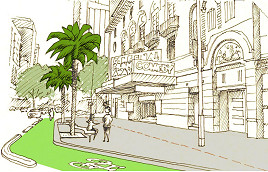An unwanted tag: Singapore meeting exposes City of Melbourne’s dilemma
The City of Melbourne is coming down harder than ever on graffiti, yet street art remains one of the city’s biggest selling points. Can the council have it both ways?
It was a minor footnote in a council report that said so much.
A report presented to councillors proposing Lord Mayor Sally Capp travel overseas for an upcoming international engagement wouldn’t usually garner any interest.
These trips, filed under opportunities for “international engagement”, are par for the course in the city’s top office.
Councillors generally spend little time speaking to the motion, and in 99.9 per cent of cases those in the chamber raise their hands to support the trip, swiftly moving onto the next item.
This occasion, on May 31, was no different.
Cr Capp’s upcoming trip to the Word Cities Summit (WCS) in Singapore, which the council would partly fund to the tune of $5000, was approved.
But a note at the bottom of the report from management raised eyebrows outside Town Hall.
Alongside key engagements as part of the July 31 to August 4 trip (including a presentation at the WCS Mayors Forum) was a planned meeting with Singaporean officials.
The subject of this meeting? How the Asian city-state deals with graffiti.
“City of Melbourne has increased activity and resourcing to tackle graffiti and street cleaning, to improve public spaces and ensure the city is sparkling as workers, students and visitors return,” the report from CEO Justin Hanney noted.
“Singapore is one of the cleanest cities in the world and meetings are proposed on Singapore’s graffiti removal and street cleaning programs.”
From a Melbourne-based perspective the meeting appears problematic, for a number of reasons.
The first, and perhaps most obvious, is that it is abundantly clear how and why Singapore is able to keep their streets mostly free of graffiti. And that is, they employ draconian laws around vandalism.
Singapore has severe penalties, which can include corporal punishment and jail, for unapproved street art.
The second, more worrying reason is that the council is now actively looking for advice from a city that takes a zero tolerance approach to street art.
It’s a dangerous side to be on.
Especially when you consider how crucial the promotion of “laneway art” is to Melbourne visitation and tourism.
As renowned local artist and Blender Studios director Adrian Doyle noted in his column for sister publication CBD News last month: “Urban art culture is used as one of the main marketing tools of Melbourne and Victorian tourism … marketing teams are quick to push it as true urban Melbourne. It’s in every magazine and all over the airport in every terminal.”
The council itself spruiks the city as boasting a “world-renowned street art scene”.
So why, then, would the city look to one of the world’s strictest, most tightly regulated street art scenes for advice?
Of course, the council does not have a say in criminal laws and can’t throw anyone in jail for illegally using a spray can in one of its many laneways.
Further, it will argue that there is a difference between street art (which it defines as “artistic work done with the permission of the person who owns the wall that the work is being done on”) and graffiti (“any writing or images on property without permission and typically includes tagging, writing, etching, stencilling, images or scribbling”).
But which ever way you dice it, the optics aren’t great on looking to Singapore for guidance on dealing with graffiti.
The planned meeting with Singaporean officials follows the recent release of the City of Melbourne’s draft 2022-23 budget where the council will spend $28.2 million to “clean up our streets and keep them free from graffiti” in the next 12 months.
This is more than it has ever spent.
But who decides which graffiti goes, and which stays?
Ugly, indiscriminate tagging across the State Library presented a clear case for the former and was swiftly removed.
But reports have also surfaced in recent months of notable street artists having creative works quickly taken down.
Doyle wrote in his column about the problem with “graffiti removalists becoming the unwitting curators of the street”.
The predicament the council finds itself in is difficult.
The city is finally welcoming back hordes of visitors after a two-year lull due to the pandemic and, understandably, Town Hall wants to present the best version of Melbourne for visitors by keeping it as clean as possible.
This is an admirable move that few would disagree with.
But Melbourne and Singapore should be at opposite ends of the spectrum when it comes to regulating graffiti.
One celebrates it as one of the city’s defining features, while the other takes a zero-tolerance approach.
One would hope our city can formulate a more nuanced viewpoint. •

Council endorses office tower at Flinders Lane despite querying car park demolition






 Download the Latest Edition
Download the Latest Edition